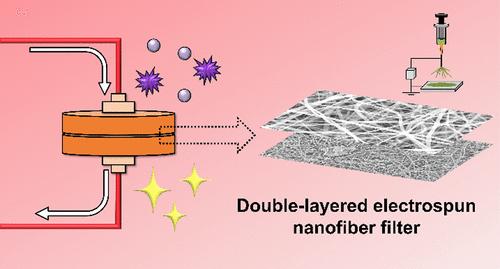Double-Layered Electrospun Nanofiber Filter for the Simultaneous Removal of Urea and Ammonium from Blood
IF 8.2
2区 材料科学
Q1 MATERIALS SCIENCE, MULTIDISCIPLINARY
引用次数: 0
Abstract
A major challenge in the development of wearable artificial kidneys (WAKs) lies in the efficient removal of urea, which is found at an extremely high concentration in the blood of patients with chronic kidney disease (CKD). Urease is an enzyme that hydrolyzes urea. While it can efficiently remove urea, toxic ammonium is produced as a byproduct. In this study, nanofibers capable of removing both urea and ammonium from the blood were fabricated. Specifically, urease was immobilized on electrospun poly(ethylene-co-vinyl alcohol) (EVOH)/chitosan nanofiber membranes via covalent cross-linking. Chitosan not only helped covalent immobilization via its free amino groups but also improved hemocompatibility by suppressing protein adhesion. The resulting urease-immobilized EVOH/chitosan nanofibers exhibited an outstanding urea removal performance of 690 mg/g per hour. For ammonium removal, EVOH nanofiber membranes containing sodium cobalt(II) hexacyanoferrate(II) (NaCoHCF), an ammonium adsorbent, were prepared. The fabricated EVOH/NaCoHCF membranes exhibited an ammonium adsorption capacity of 135.5 mg/g. The two types of nanofiber membranes were combined to form a double-layered nanofiber membrane that was placed in a filter holder for continuous-flow cycling experiments. Under such conditions, all urea at a concentration similar to that in the blood of CKD patients was degraded within 1 h, and ammonium production was reduced by approximately 90% of the normal level. This double-layered nanofiber membrane can achieve both urea degradation and ammonium adsorption and is expected to advance the development of WAKs, a game changer in the treatment of CKD.

用于同时去除血液中尿素和铵的双层电纺纳米纤维过滤器
开发可穿戴式人工肾(WAKs)的一大挑战在于如何有效清除慢性肾病(CKD)患者血液中浓度极高的尿素。尿素酶是一种水解尿素的酶。虽然它能有效清除尿素,但会产生有毒的铵作为副产品。在这项研究中,制备出了能够同时去除血液中尿素和铵的纳米纤维。具体来说,脲酶通过共价交联被固定在电纺聚乙烯醇(EVOH)/壳聚糖纳米纤维膜上。壳聚糖不仅能通过其游离氨基帮助共价固定,还能通过抑制蛋白质粘附来改善血液相容性。最终得到的脲酶固定化 EVOH/ 壳聚糖纳米纤维具有出色的尿素去除性能,每小时可去除 690 毫克/克尿素。为了去除铵,制备了含有铵吸附剂六氰合铁酸钠(NaCoHCF)的 EVOH 纳米纤维膜。制备的 EVOH/NaCoHCF 膜的铵吸附容量为 135.5 mg/g。将这两种纳米纤维膜组合成双层纳米纤维膜,并将其置于过滤器支架中进行连续流循环实验。在这种条件下,与慢性肾脏病患者血液中浓度相似的尿素在 1 小时内全部被降解,氨的产生量减少了正常水平的约 90%。这种双层纳米纤维膜既能降解尿素,又能吸附铵,有望推动 WAK 的发展,改变 CKD 治疗的现状。
本文章由计算机程序翻译,如有差异,请以英文原文为准。
求助全文
约1分钟内获得全文
求助全文
来源期刊

ACS Applied Materials & Interfaces
工程技术-材料科学:综合
CiteScore
16.00
自引率
6.30%
发文量
4978
审稿时长
1.8 months
期刊介绍:
ACS Applied Materials & Interfaces is a leading interdisciplinary journal that brings together chemists, engineers, physicists, and biologists to explore the development and utilization of newly-discovered materials and interfacial processes for specific applications. Our journal has experienced remarkable growth since its establishment in 2009, both in terms of the number of articles published and the impact of the research showcased. We are proud to foster a truly global community, with the majority of published articles originating from outside the United States, reflecting the rapid growth of applied research worldwide.
 求助内容:
求助内容: 应助结果提醒方式:
应助结果提醒方式:


